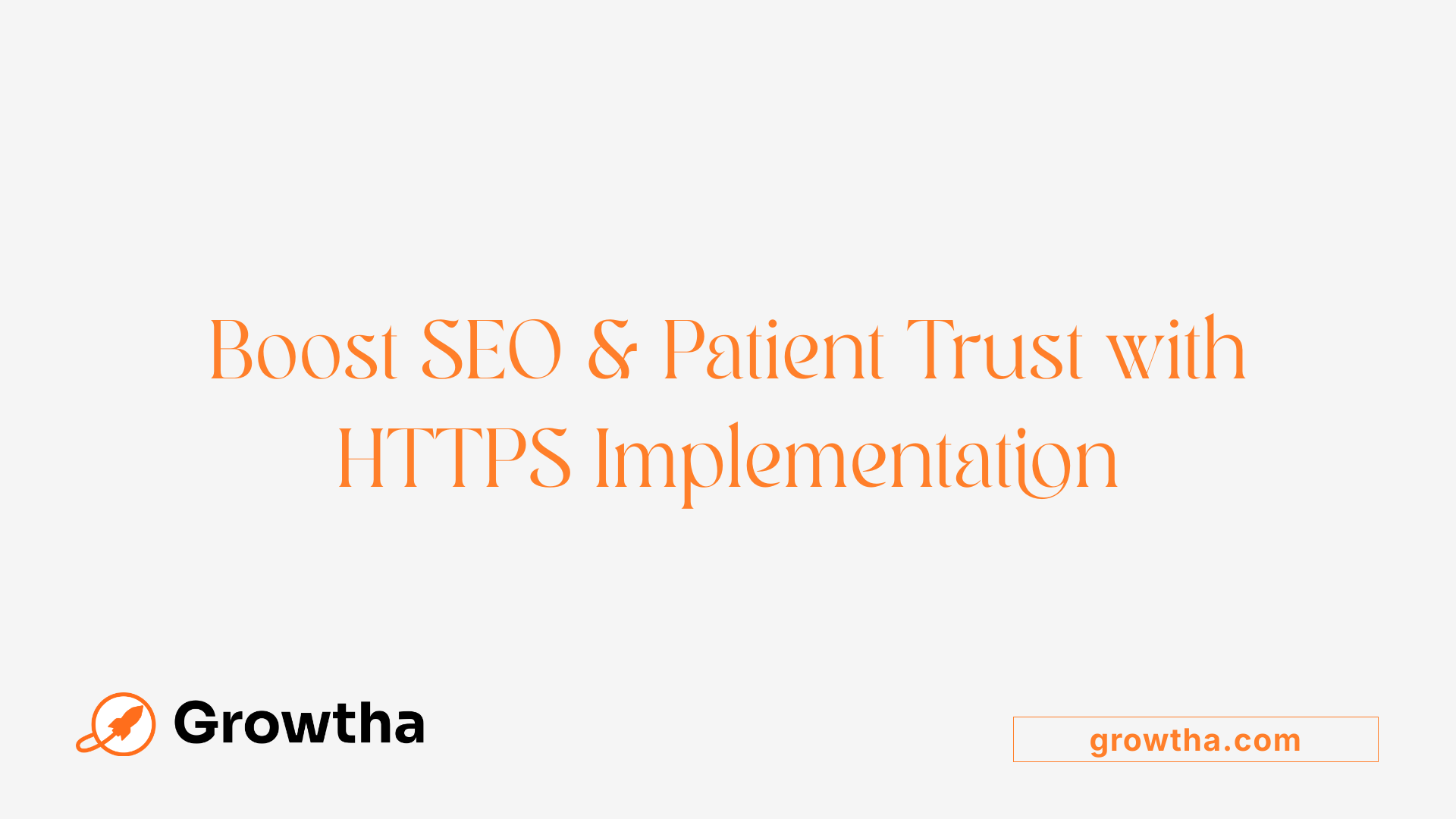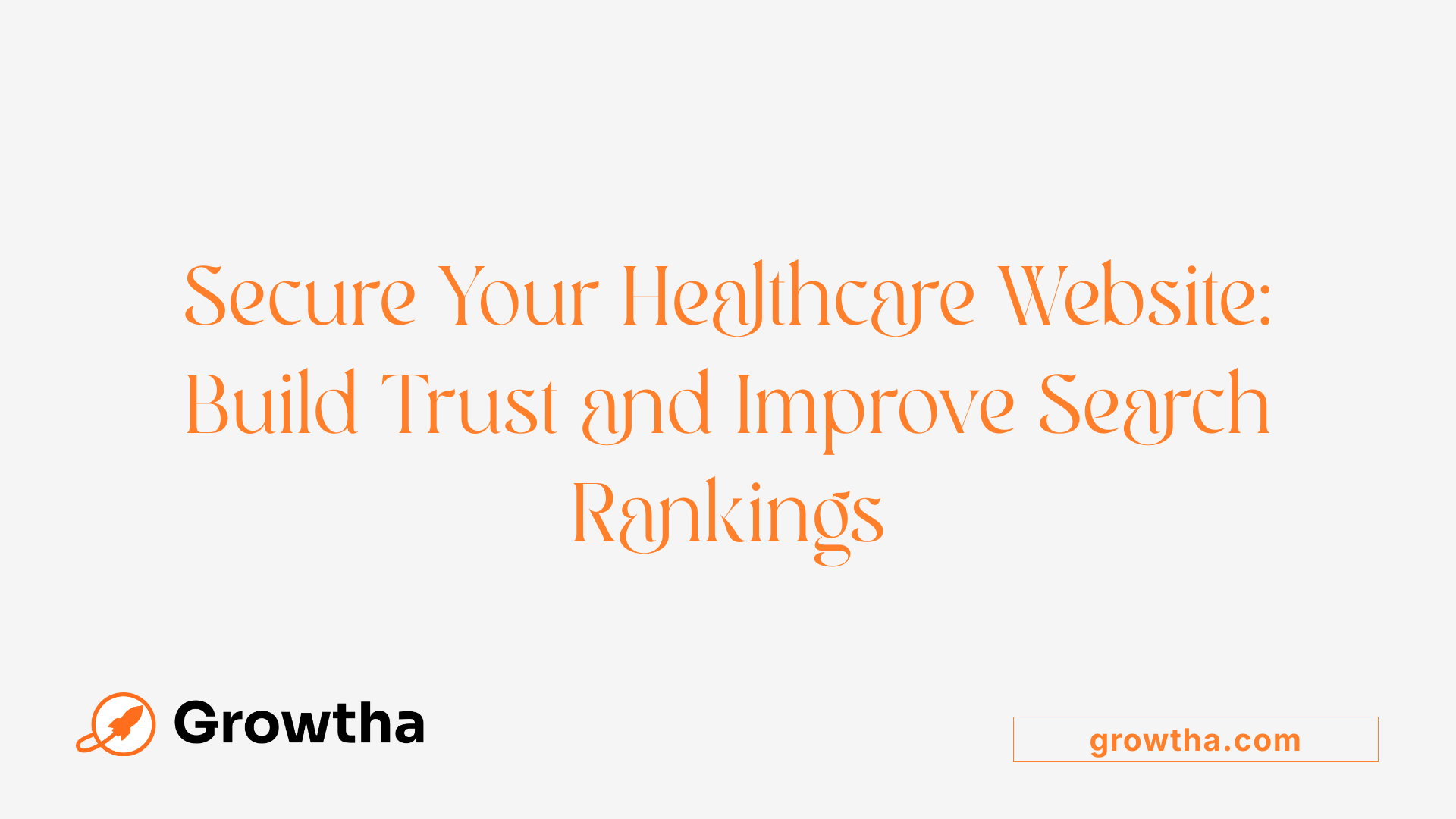How to Secure Your Healthcare Website (HTTPS and SEO)
Enhancing Security and Visibility for Healthcare Providers


How to Secure Your Healthcare Website (HTTPS and SEO)
Introduction
In today's digital health landscape, securing your healthcare website is paramount not only for protecting patient data but also for improving search engine rankings and establishing trust. Implementing HTTPS with SSL certificates, optimizing for SEO, and adhering to regulatory standards like HIPAA are essential strategies. This comprehensive guide explores best practices, implementation steps, and the benefits of combining robust security with effective SEO to boost your healthcare practice's online presence.
Best Practices for Securing Healthcare Websites with HTTPS
What are best practices for securing healthcare websites with HTTPS?
Implementing HTTPS across your healthcare website is essential for protecting patient data and boosting trust. The first step is obtaining a valid SSL/TLS certificate from a reputable Certificate Authority. Once acquired, properly configure the certificate on your web server, ensuring it uses strong encryption protocols like TLS 1.2 or 1.3.
To avoid mixed content issues where some resources load insecurely, update all internal links, images, scripts, and external resources to HTTPS. This ensures that every element on your site is encrypted and prevents security warnings that can undermine credibility.
HIPAA compliance demands that all data transmitted through your website be encrypted, particularly with sensitive patient information. Use strong encryption algorithms such as AES-256 for data at rest and ensure access controls are strict, including audit logs to monitor activity.
Regular security updates are critical. Keep all software, plugins, and server components current to protect against vulnerabilities. Staff training on privacy policies and security best practices can prevent accidental disclosures or misconfigurations.
Maintaining secure backups and disaster recovery plans is necessary for electronic protected health information (ePHI). These plans should enable quick recovery from ransomware attacks or data loss, ensuring ongoing compliance and service availability.
Additionally, incorporate HTTPS into every page, including patient portals and forms, to safeguard all touchpoints where sensitive data could be transmitted. Design sites with clear navigation, accessibility standards (WCAG, ADA), and patient-friendly content to enhance usability.
Continuous monitoring using security tools, staff education on HIPAA standards, and regular audits are vital for ongoing security. Establishing business associate agreements with third-party providers and ensuring they meet HIPAA standards will further bolster your security posture.
In summary, securing healthcare websites with HTTPS involves careful certificate management, encryption, compliance adherence, and staff awareness. These practices build patient trust, protect sensitive health information, and improve your site's search visibility and credibility.
SEO Benefits and Trust Building through HTTPS
 Implementing HTTPS on healthcare websites offers numerous advantages for both search engine optimization and patient trust. Search engines like Google recognize HTTPS as a ranking signal, meaning secure sites are favored in search results. This boost in visibility can lead to increased organic traffic and more patient inquiries.
Implementing HTTPS on healthcare websites offers numerous advantages for both search engine optimization and patient trust. Search engines like Google recognize HTTPS as a ranking signal, meaning secure sites are favored in search results. This boost in visibility can lead to increased organic traffic and more patient inquiries.
HTTPS also significantly enhances user confidence. When visitors see the secure padlock icon in their browser, they feel reassured that their sensitive data, such as health information, is protected. This trust encourages longer visits, more engagement, and the use of patient portals or contact forms.
Protection of sensitive data is vital in healthcare. Encrypting information reduces the risk of data breaches and demonstrates a healthcare provider’s commitment to privacy, strengthening their credibility and reliability.
The overall effect of adopting HTTPS is a more trustworthy and authoritative online presence that attracts and retains more visitors. It also helps improve site speed and performance metrics, which are important for SEO rankings.
| SEO Aspect | Benefit | Additional Details |
|---|---|---|
| Search Rank | Higher in results | Recognized by Google as a positive ranking factor |
| User Trust | Increased confidence | Visible security indicators reduce warnings |
| Data Protection | Safeguarding patient info | Essential for HIPAA compliance and privacy |
| Traffic & Engagement | Boosted site visits | Encourages longer visits and resource use |
In summary, enabling HTTPS safeguards patient data, builds user trust, and enhances your healthcare website’s visibility in search rankings—an essential component of modern healthcare SEO strategies.
Strategies to Improve SEO and Security Simultaneously

What strategies can healthcare providers use to improve SEO alongside website security?
Healthcare providers can effectively enhance both SEO and website security by adopting a multi-faceted approach. First, creating high-quality, patient-focused content that incorporates relevant keywords and emphasizes the E-E-A-T principles (Experience, Expertise, Authority, Trustworthiness) boosts credibility and helps search engines recognize authority.
Securing the website with HTTPS using an SSL certificate is essential. This not only protects sensitive patient data but also signals to Google that the site is trustworthy, which can improve search rankings. Regularly checking for and fixing mixed content issues post-migration ensures that all media loads securely, maintaining user trust.
Optimizing technical SEO elements like site speed, mobile responsiveness, and accessibility enhances user experience and aligns with search engine algorithms.
Local SEO is crucial for healthcare practices—claiming and optimizing Google My Business profiles, incorporating local keywords, and managing reviews increase visibility in geographically targeted searches.
Structuring the website with a clear, logical architecture and internal links helps both users and search engines navigate effectively. Using schema markup can also earn rich snippets in search results, attracting more visitors.
Finally, partnering with specialized healthcare SEO professionals for ongoing monitoring and updates, while ensuring compliance with regulations like HIPAA, creates a balanced strategy that enhances both SEO performance and security.
This comprehensive approach leads to higher search rankings, increased patient trust, and a safer online environment, making it a critical focus for modern healthcare providers.
Building Trust and Credibility with HTTPS and SEO
 Healthcare organizations can significantly boost their reputation by combining strong technical security measures with authoritative content. Securing the website with HTTPS encrypts data exchanges, reassuring patients that their information is protected. This security feature not only fosters trust but also positively influences search engine rankings.
Healthcare organizations can significantly boost their reputation by combining strong technical security measures with authoritative content. Securing the website with HTTPS encrypts data exchanges, reassuring patients that their information is protected. This security feature not only fosters trust but also positively influences search engine rankings.
Creating high-quality, fact-based content authored or reviewed by qualified medical professionals adds credibility. Patients seek trustworthy information on health topics, and demonstrating expertise through accurate, current content establishes authority. Showcasing credentials, certifications, and including comprehensive author bios reinforces the organization’s trustworthiness.
Applying the E-E-A-T principles—Experience, Expertise, Authority, and Trustworthiness—further distinguishes credible healthcare websites. This includes citing reputable sources, linking to authoritative sites, and maintaining transparency in privacy policies and contact details.
Furthermore, optimizing the website’s technical aspects, like fast loading speeds, mobile-friendliness, and structured data markup, enhances user experience and improves ranking signals. Active management of online reputation, including encouraging patient reviews and engaging with feedback, helps build community trust.
In sum, integrating security, authoritative content, professional credentials, and reputation management creates a trustworthy online environment that benefits both patients and healthcare organizations.
Regulatory and Privacy Considerations in HTTPS Implementation
Implementing HTTPS on healthcare websites involves critical privacy and security considerations aligned with HIPAA regulations. Ensuring all electronic protected health information (ePHI) is encrypted during transmission using protocols like TLS 1.2 or higher is essential for safeguarding patient data. Encryption at rest, such as with AES-256, also contributes to comprehensive data protection.
Healthcare organizations must perform thorough risk assessments to identify potential vulnerabilities, then develop and enforce policies that incorporate administrative, physical, and technical safeguards consistent with HIPAA Security and Privacy Rules. These safeguards include access controls, audit logging, regular staff training, and secure authentication practices.
Vendor management plays a vital role; organizations should establish Business Associate Agreements (BAAs) with third-party hosts and service providers to ensure compliance. Any online forms, patient portals, or features that handle PHI must be secured with end-to-end encryption and robust security measures to prevent unauthorized access or accidental disclosures.
Continuous monitoring is necessary to maintain compliance. Regular security audits, vulnerability scans, and review of privacy notices help ensure ongoing adherence to HIPAA standards. Clear privacy notices inform patients about how their data is protected and used, which is vital for building trust.
In sum, combining strong encryption, diligent risk management, proper vendor agreements, and ongoing compliance checks ensures healthcare providers meet legal obligations and maintain patient trust while implementing HTTPS.
Enhancing Online Security and Search Performance

What techniques can be used to improve online security and search performance for healthcare websites?
Healthcare organizations can significantly boost their website's security and visibility by adopting multiple strategies.
First, implementing encryption through SSL/TLS certificates is essential. Moving from HTTP to HTTPS ensures data transmitted between the website and visitors remains secure. Regularly updating and renewing SSL certificates, along with conducting security audits, helps maintain a strong security posture.
To prevent cyber threats, deploying firewalls and intrusion detection systems offers an added layer of protection. These tools monitor traffic for suspicious activity and block potential attacks in real-time.
Protecting patient privacy is especially critical under HIPAA regulations. Ensuring all data handling complies with privacy standards involves safeguarding Protected Health Information (PHI) and avoiding sharing personally identifiable information without consent.
Consistent security monitoring includes analyzing security logs, updating software, and applying patches promptly. Hosting websites on secure servers with proper configurations also reduces vulnerabilities.
Beyond security, optimizing for search performance is crucial. This involves creating a responsive site design that loads quickly—preferably under three seconds—on both desktop and mobile devices.
Local SEO plays a vital role; claiming and optimizing Google My Business listings, managing online reviews, and featuring local keywords improve visibility in nearby search results.
Creating authoritative, patient-centric content—such as FAQs, blog posts, and multimedia—is vital for both SEO and user trust. Incorporating structured data like schema markup enhances search engine understanding, improving rich snippets and click-through rates.
Maintaining website accessibility and ADA compliance ensures all users can access information easily, further enhancing trust and legal adherence.
In summary, combining robust security measures with effective SEO tactics creates a safe and visible online presence, strengthening patient confidence and attracting more visitors.
The Role of EEAT and Conclusion

How do EEAT principles contribute to the security and optimization of healthcare websites?
EEAT—Experience, Expertise, Authority, and Trustworthiness—are fundamental to establishing a credible online healthcare presence. Demonstrating these qualities involves showcasing qualified professionals, citing reputable sources, and producing accurate, up-to-date content. This not only boosts search engine rankings but also builds patient confidence.
In terms of security, EEAT encourages practices like implementing SSL certificates, maintaining transparent privacy policies, and ensuring secure data handling. These elements foster trustworthiness by signaling that the website values user privacy and data protection.
Furthermore, regular content updates, engaging responsibly with online reviews, and providing clear contact information demonstrate ongoing credibility and professionalism. Integrating EEAT with strong security measures results in a reliable, authoritative website that appeals to both Google and patients.
Why is a combined approach to security and SEO crucial for healthcare websites?
Combining security and SEO strategies is essential because they mutually reinforce each other. Secure websites using HTTPS and SSL certificates not only protect sensitive health information but also improve search rankings, as Google favors secure sites.
High-quality content aligned with EEAT principles enhances authority and trustworthiness, encouraging more patient interactions and conversions. Technical SEO—including mobile optimization, site speed, and structured data—aims to make the site more accessible, trustworthy, and easier for search engines to index.
By focusing on both security and SEO, healthcare providers ensure compliance with regulations like HIPAA, foster patient trust, and increase visibility in local search results. Ultimately, this integrated approach supports a safe, authoritative, and easy-to-find online platform that effectively serves patient needs and enhances the practice’s reputation.
| Aspect | Focus Area | Benefit |
|---|---|---|
| Security | HTTPS and SSL, Privacy Policies | Protects patient data, boosts search rankings |
| Content | E-E-A-T principles, Reputable sources | Builds authority, trust, and credibility |
| Technical SEO | Site speed, Mobile-friendliness, Structured data | Improves user experience and discoverability |
| Local SEO | Google My Business, Reviews, Local keywords | Attracts nearby patients |
| Ongoing Engagement | Content updates, Review management | Maintains relevance and trustworthiness |
Incorporating both security and SEO practices ensures healthcare websites are trustworthy, visible, and patient-centered, meeting both regulatory requirements and user expectations.
Final Thoughts
Securing your healthcare website with HTTPS is not merely a technical requirement but a fundamental element of building trust, improving SEO, and ensuring compliance with regulations like HIPAA. Combining robust security practices with strategic SEO efforts—such as local optimization, authoritative content, and technical enhancements—creates a powerful digital presence that attracts and retains patients. Regular audits, continuous updates, and adherence to EEAT principles further reinforce trustworthiness and visibility. By integrating these strategies holistically, healthcare providers can enhance their online reputation, safeguard patient data, and achieve long-term success in the digital landscape.
References
- How to Optimize Your Healthcare Website for Better SEO - DearDoc
- The Power of HTTPS: Optimizing Healthcare SEO for Search Engines
- Mastering SEO for Healthcare Providers | Workshop Digital
- Authority in SEO – Applying E-E-A-T Principles for Medical Websites
- The Only Healthcare SEO Strategy Guide You'll Ever Need - Sure Oak
- Healthcare SEO: 8 Steps To Boost Your Organic Performance
- Boost Your Healthcare Website Success With Technical SEO
- Implementing HTTPS for Secure Browsing and SEO - Senna Labs







